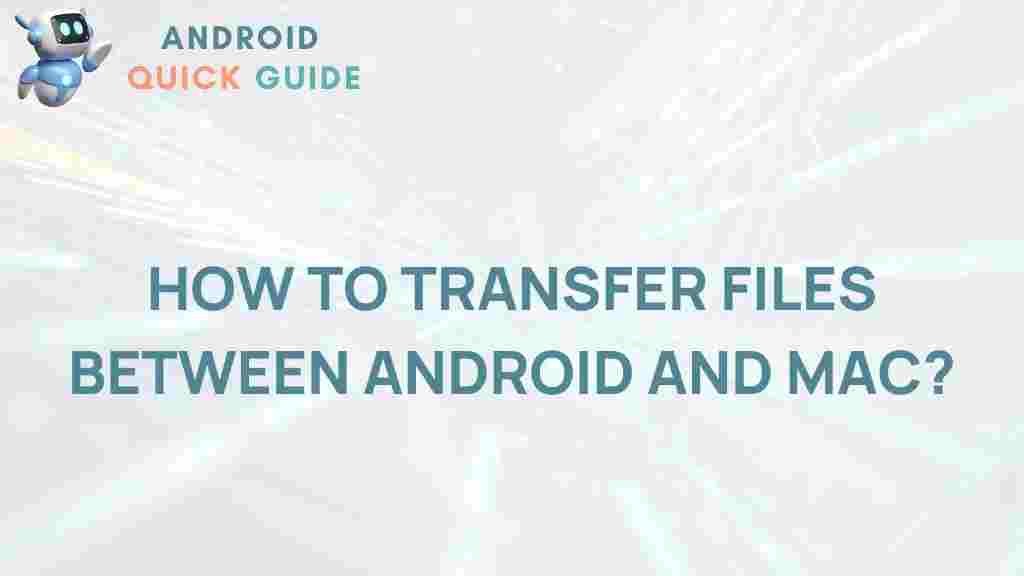File Transfer: Unveiling the Secrets of File Transfer Between Android and Mac
Transferring files between Android devices and Mac computers can seem daunting at first, but understanding the process can make it straightforward and efficient. Whether you’re looking to share documents, photos, or music, mastering the art of file transfer is essential for seamless communication and organization in our digital lives. In this guide, we will explore various methods to facilitate file transfer between Android and Mac, troubleshooting tips, and best practices to ensure a smooth experience.
Understanding the Need for File Transfer
As we rely more on our devices, transferring files between them becomes crucial. Here are some reasons why you might need to perform a file transfer:
- Data Backup: Regularly transferring files to your Mac ensures you have backups of important documents and photos.
- File Sharing: Sharing large files with friends or colleagues is easier with direct file transfer.
- Device Transition: When upgrading your Android device, you’ll want to move your files to the new device.
Methods for File Transfer Between Android and Mac
There are several effective ways to transfer files between your Android device and Mac. Here, we’ll cover the most popular methods.
1. Using Android File Transfer
Android File Transfer is an official application by Google designed for Mac users. Follow these steps to utilize this method:
- Download and Install: Visit the Android File Transfer website and download the application. Install it on your Mac.
- Connect Your Device: Use a USB cable to connect your Android device to your Mac.
- Open Android File Transfer: Once connected, launch the Android File Transfer app on your Mac. If it doesn’t open automatically, you can find it in the Applications folder.
- Transfer Files: You’ll see a window displaying the files on your Android device. Drag and drop the files you wish to transfer or copy and paste them as needed.
2. Using Cloud Storage Services
Cloud storage offers a convenient alternative to direct file transfer. Here’s how to use it:
- Choose a Service: Select a cloud service such as Google Drive, Dropbox, or OneDrive.
- Upload Files: On your Android device, open the cloud storage app and upload the files you wish to transfer.
- Access on Mac: Open the same cloud service on your Mac and download the files.
3. Using Bluetooth
Bluetooth provides a wireless method for file transfer. To transfer files using Bluetooth:
- Enable Bluetooth: Turn on Bluetooth on both your Android device and Mac.
- Pair Devices: On your Mac, go to System Preferences > Bluetooth and select your Android device to pair.
- Send Files: On your Android device, choose the file you want to send, tap “Share,” and select Bluetooth. Choose your Mac as the recipient.
4. Using Third-Party Applications
Several third-party applications can facilitate file transfer between Android and Mac:
- SyncMate: This application allows for seamless synchronization of files, folders, and even SMS messages between Android and Mac.
- AirDroid: A popular tool that offers file transfer and device management features over Wi-Fi.
- Pushbullet: Useful for sharing links and files instantly between devices.
Troubleshooting Common File Transfer Issues
Despite the convenience of various methods, you may encounter some common issues. Here are some troubleshooting tips:
- Connection Problems: If your Mac doesn’t recognize your Android device, try using a different USB cable or port. Ensure your device is set to “File Transfer” mode.
- Slow Transfer Speeds: Large files may take longer to transfer. For quicker transfers, try using a wired connection instead of Bluetooth.
- Software Issues: Ensure that both your Mac and Android device are updated to the latest software versions.
Best Practices for File Transfer
To enhance your file transfer experience, consider these best practices:
- Regular Backups: Regularly back up your files to avoid data loss.
- Use High-Quality Cables: For USB transfers, use original or high-quality cables to ensure a stable connection.
- Organize Files: Maintain a well-organized file structure on both devices to easily locate and transfer files.
Conclusion
Mastering file transfer between Android devices and Mac can significantly enhance your productivity and ensure that your data remains accessible wherever you are. With various methods available, from Android File Transfer to cloud services and third-party applications, you have plenty of options to suit your needs. Remember to follow best practices and troubleshoot common issues to ensure a smooth file transfer experience. By utilizing these tips and techniques, you can simplify your digital life and keep your devices in sync.
For more tips on digital device management, visit our resource page or explore more about Android and Mac compatibility.
This article is in the category Guides & Tutorials and created by AndroidQuickGuide Team
